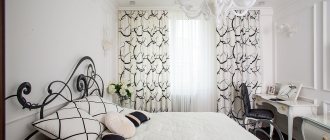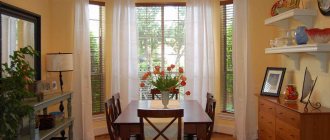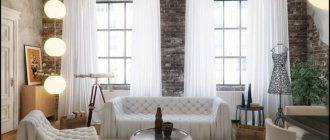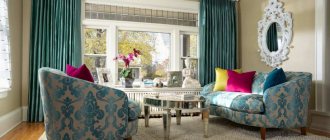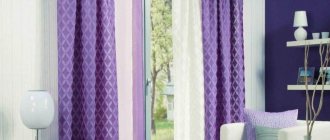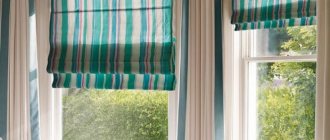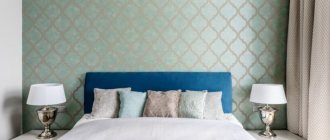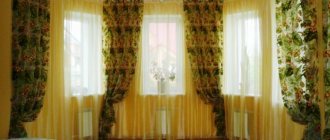Decorating curtains in the form of a lambrequin is used not only in pompous classic interiors. Many designers allow such an elegant addition when decorating rooms in different styles.
The element looks festive, making the room beautiful and cozy. For a design like the one in the picture, you can buy ready-made curtains with a lambrequin or sew a textile composition yourself.
The essence of a decorative element
Lambrequin is classified as a decorative element. A beautifully designed strip of fabric is designed to hide the cornice. The element completes the aesthetics of the textile window frame.
A complete composition of curtains, curtains, and lambrequins looks elegant. The window takes on a gorgeous look. This is clearly visible in the photo of curtains with a lambrequin.
Existing types
There are classic, openwork, combined lambrequins. It is better to start sewing curtains with lambrequins with your own hands with simple traditional models.
Classic decorative elements are a regular piece of fabric, which is often draped in folds. The lower part of the strip can be made in the form of an arch or cut out in a curly wave.
Openwork decorative elements or bandeaus look elegant, but are difficult to execute. A pattern is applied to the cut strip of fabric. Cuts are made along the boundaries of the parts. The edges are processed.
The product must be glued with non-woven material and placed on a lining. The decoration must remain rigid.
A combined lambrequin combines different decorative elements. Bandeaus are often combined with throws, frills, molds, and various types of draperies.
To independently perform such a product requires considerable experience. Beginners are not recommended to try to create a masterpiece without prior training in making each element.
General concepts and useful tips
But before you dive into the abyss of the intricacies of sewing, it’s worth understanding the basic concepts and taking into account some of the subtleties that will allow you to create the perfect lambrequin from flying fabric.
Lambrequin is a decorative horizontal detail at the top of any type of curtain. Usually it looks like a fabric assembled with folds, the width of the entire cornice.
The lambrequin does not carry any functional load and is simply a decorative element.
It is often decorated with all kinds of scallops and tiebacks; beads and other accessories can also be used. Often, a lambrequin does not carry a functional load and is solely a decorative element.
A veil is a translucent, thin, flying material. It differs from organza in its softness, which makes it easy to create beautiful draperies. The fabric practically does not protect from direct sunlight; for bright rooms it is better to choose a veil of rich or dark shades.
So, a suitable model of window decoration has been selected, the material has been purchased, what else do you need to know in order for the do-it-yourself lambrequin to meet all expectations:
- The most difficult and important stages are the construction of the pattern and the actual cutting. The slightest miscalculation can result in a skewed window accessory.
- Thin airy fabric must be cut diagonally. This will avoid skewing the fabric, and the folds will be even and symmetrical.
- It is important not to forget that the calculation of the required amount of material depends on the model of the lambrequin.
- For the kitchen it is better to choose discreet curtains, and some pomp will fit into the interior of the bedroom and living room.
- The modern market for interior materials offers a wide selection of fabrics with figured edges. Purchasing such a veil will greatly simplify your work, and you will be able to avoid such a painstaking step as processing the sections.
Related article: Rotband plaster consumption calculator per 1m2
Fabric selection
The first thing to consider is the thickness of the fabric, which affects the visual effect of the product. Taffeta, silk, and polyester will provide the decorative element with lightness and ease of draping.
Curtains with a lambrequin will look airy and flow gracefully across the window. This option is suitable for making simple classic elements.
Satin, cotton, linen, jacquard or plush are good for dense, complex products. They will give the room solid respectability and an elegant look.
Such curtains with a lambrequin are ideal for the hall. Although a bedroom or kitchen in a classic style with a similar window design will look no worse.
Veil in the interior
Voile curtains for the bedroom add lightness and grace to the room. It is recommended to give preference to a material that scatters the sun's rays, but does not delay them.
It will also be interesting: Velvet - what kind of fabric, types of velvet and use in the interior
The design of curtains made from this material allows you to embody the most daring ideas, creating unusually beautiful interiors. In the summer, many people choose a veil, combining it with curtains made of thick fabrics to create twilight. In winter, voile curtains can be used separately if there is no need to protect the room from bright sunlight.
When decorating a window opening in the hall, you should observe conciseness and moderation. You can use voile tulle to highlight beautiful main curtains. If you completely abandon thick curtains, you can choose a veil for curtains in several contrasting shades.
When decorating a kitchen window, there is no point in overloading the room with multilayer structures. Voile curtains for the kitchen can be made single-layer using an unusual cut:
- French - remain elegant and stylish in any interior;
- Austrian - can cover half a window or the entire opening, constantly creating a feeling of celebration and lightness.
Not all materials are suitable for kitchen curtains. Some cannot tolerate ultraviolet radiation and begin to deteriorate. Tulle allows air and light to pass through well, but quickly collects dust.
Living room curtains made of lightweight fabric look stylish and attract attention. A room without them looks empty and uncomfortable. The living room is considered the main room in the house, so the design of its windows is of great importance.
When using a classic design, curtains are made in the form of a straight canvas, decorated with vertical folds. Their number depends on the length of the fabric.
The Austrian style is considered especially luxurious, it includes lush folds and a scalloped bottom. The English style is distinguished by rounded folds at the bottom of the voile curtains.
Often, classic curtains are complemented with a lambrequin of a contrasting color or a color that differs by several tones. Wave-shaped lambrequins are gradually becoming a thing of the past, replaced by simpler ones.
You may also be interested in: Crepe fabric for curtains - its types and properties
There is a rule: the width of a product made of translucent material should be 1.5 - 2 times greater than the length of the cornice. Plain curtains made of light fabric will fit perfectly into the interior of most living rooms, in contrast to canvases with stripes (vertical or horizontal).
It is recommended to have 2 sets of light curtains (for winter and summer or for holidays and everyday life). In dark rooms, the use of a microveil will be justified. It is much thinner and has a shiny surface.
Tools, patterns
There is no special pattern for a simple lambrequin. It is enough to know the length of the cornice and make extra allowances for beautiful drapery. To make a bandeau, draw the desired pattern on paper.
- Provence curtains - design ideas and review of ideal combinations of curtains in a rustic style (110 photos and videos)
Yellow curtains: types, fabrics, shades and use in the interior. 115 photo examples of ideal combinations
Openwork curtains: beautiful models, original selection ideas and application options (110 photos and videos)
In addition to the fabric, you will have to prepare:
- curtain tape;
- threads;
- bias tape.
You may also need interlining, additional fabric for lining, pins, and decorative elements (fringe, cords, beads).
Assembling a lambrequin from a veil
This moment is considered the most important and exciting, since all the work done will be visible here. At this moment, many are wondering how to assemble it correctly? It must be remembered that the details must complement each other, creating a single, holistic picture.
Advice:
You can draw a work diagram on paper, like a pattern. This will help create better markings and mark connection points for each part without the need to spoil the fabric.
Next, all parts are applied sequentially to one another and pinned together with pins. It is necessary to determine in advance where the elements will touch, so that you can only pin them together with pins or sweep them together with a light stitch.
The resulting lambrequin blank needs to be measured in length - if it differs from what was originally planned, then you will have to disassemble the entire structure and make the necessary changes.
Advice:
You should not exactly adjust the length of the lambrequin to the length of the cornice; it is better to leave a few centimeters in reserve - this will allow you to adjust the decorative element as accurately and beautifully as possible. After this, all that remains is to fix the resulting lambrequin on the cornice and hang it on a window opening or on a curtain; you can also use it to decorate an arch or doorway.
Thus, any housewife can create an unusual, original lambrequin from the finest veil. There is nothing complicated or impossible in this work. All that is required is to choose the appropriate fabric, model and style, show accuracy and attention to detail, after which all that remains is to admire your own creation, which will give any room coziness, comfort and a little romance and tenderness, which is so lacking in the modern world.
Line element
First, a strip of fabric is cut out, focusing on the dimensions of the cornice, the main curtains, and the height of the ceilings. The edges are treated with bias tape or a special edging. A curtain tape is sewn on top.
When making a rigid lambrequin, a similar part is cut out from non-woven fabric, and the base is glued using an iron. Additionally, the lining is sewn on. After this, border processing begins.
Sewing technology
How to sew curtains with your own hands? It's not difficult at all. First you need a sketch. According to experts, touches of color need to be applied to it to check the combination with the interior of the room. The finished product should touch the floor, so you will need to add 25 to 30 cm to the desired length.
Having laid out the material face up, you need to align the edges. We will sew a special ribbon with loops on it to the top one. It is important to select threads of the desired tone and adjust the quality of the stitch (thread tension) so that the stitching is not noticeable on the finished product.
Now let's look at how to sew curtain tape. The main fabric along the upper edge needs to be folded inside out and the tape basted. On the sides of the product, the braid is folded 2 cm, and it is sewn first along the top and then along the bottom edge. If the tape is wide, a machine stitch is laid under each row.
To make it easier to process the side cuts, experts recommend pulling the thread out 3 cm from the edge of the panel. After this, you need to bend the edge twice and stitch. The bottom edge usually comes with a weight, so no hemming is required. This completes the sewing of the curtains.
When purchasing a translucent canvas for window decoration, you should carefully study the composition of the material and recommendations for its care. Proper care will help preserve the grace and beauty of veil products for several years.
It may also be interesting: Calico fabric - what kind of fabric is it?
Save
Save
Save
Presence of folds
The procedure for making a lambrequin with folds becomes more complicated. When cutting out parts, they do not use a simple linear pattern. A trapezoid is cut out of the fabric. The base of the figure is equal to the length of the cornice.
Fashionable curtains - modern trends and the best new designs. 125 photos of current curtains for the 2019-2020 season
- Curtains with a pattern - popular ideas and interesting combinations of using curtains with a pattern (95 photos + video)
Curtains for the balcony - application ideas, features of use and modern options for beautiful combinations (120 photos + video)
The bottom edge is processed in the usual way. A curtain tape with cords is attached to the top to make draperies. By tightening the ropes, the desired position of the assemblies is formed. This allows the product to look impressive.
There is no need to be afraid to take on sewing curtains and lambrequins. If you choose simple models and follow the instructions while working, the process will be enjoyable and the result will please you.
Preparatory stage
First of all, you should calculate the required amount of veil. And it will depend on the model of the future lambrequin.
Scheme for sewing a lambrequin.
- If the focus is on horizontal draperies and scallops, the length of the fabric can be equal to the length of the cornice + margin for processing cuts.
- If the lambrequin consists of one section with a minimum number of vertical folds, the length of the cornice multiplied by 1.5 is sufficient.
- If you plan to sew a lambrequin from 2 sections, overlapping each other by about a third, the calculation should be made using the following formula: cornice length 5 * 3 = width of one section. The resulting value must be multiplied by 2.
- The material for a 3-section lambrequin is calculated using the formula: cornice length 7*3 = section width. The result, of course, must be multiplied by 3.
- To calculate the fabric for sewing a soft lambrequin with puffs, you need to use a coefficient of 2.8 - 3.5.
So, the calculations have been made, the material has been purchased, besides it, you will need:
- convenient table for cutting;
- pins for fixing fabric;
- scissors, needles, threads;
- sewing machine;
- curtain tape;
- bias tape.
Usually a lambrequin consists of several parts. It is their combination that allows us to achieve the unique charm of this type of window decoration. The main types of parts that can be sewn without the involvement of professionals:
Pattern for a lambrequin made from strips of fabric.
- Swag is an oval sagging element characterized by perfectly symmetrical folds. It is usually mounted in the center of the window and complemented by side additions.
- De-jabot is a decorative element that is similar to a curtain, but differs in length and oblique cut. Usually complements swagi.
- Coquille is a double-sided analogue of de-jabot. It is a beautifully draped fabric, the side parts of which are cut diagonally and at the lower point converge into an original “tail”.
Now, knowing the basic elements of a lambrequin, you need to learn how to sew them well and, of course, assemble them into a finished composition. Depending on the type of lambrequin chosen, sewing patterns and the list of required materials may differ. Once everything is prepared and purchased, you can begin.
Related article: Summer kitchen, photo
Photo of curtains with lambrequin
- Green curtains - modern ideas, beautiful combinations and rules of application in interior design (115 photos + video)
Beige curtains are an immortal classic for your windows. Advantages and disadvantages of beige curtains, features of shades, useful tips for interior design
Blackout curtains: rules for choosing classic and roller opaque curtains for the bedroom, living room, kitchen. 75 photos of blackout curtains in the interior: Japanese, roller, pleated
Read: Curtains for the balcony - application ideas, features of use and modern options for beautiful combinations (120 photos + video)
Did you like the article? Please share with your friends 
0
Write a comment
New designs
Provence curtains - design ideas and review of ideal combinations of curtains in a rustic style (110 photos and videos)
Minimalism in an apartment - interior ideas and design options. Tips for using different styles (100 photos)
Kitchen-living room 20 sq. m. - design ideas, interior design options and an overview of the most stylish combinations (110 photos)
Decorating the living room - tips on choosing colors and materials. Review of the most beautiful ideas for decorating a living room (90 photos + video)
